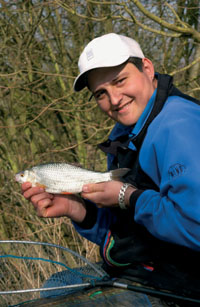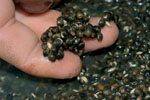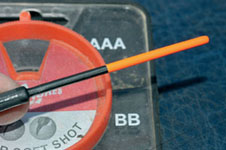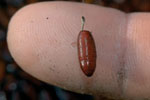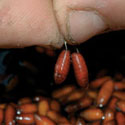Many commercial carp fisheries also have excellent populations of quality roach that provide brilliant winter sport and can win you matches. Ian Didcote shows you how to catch them fast on running-line tactics.
A WELCOME side effect of the many commercial fisheries stocked with carp is the amount of quality roach fishing many of these venues now hold.
Where there are carp, the roach seem to thrive too. Some say they get fat on the baits the carp miss. Others reckon it’s because they are ignored by so many of the ticket anglers who prefer to seek the carp and thus thrive on neglect.
Either way the fact is that winter roach sport on carp waters can be superb and Ian Didcote, who fishes at the highest level of English match fishing, just loves targeting them.
“One of the great things about targeting roach on waters like this, is that you don’t need to use expensive poles – a waggler rod and reel running-line combination is just as effective and in fact is often better because you may have to fish beyond pole range,” advised Ian.
“You just need a standard, through-action 13ft match rod. Don’t use a ‘pokey’ rod that you might choose for carp fishing. You are not going to fish at long range and you are much better off using a rod with a bit of give in it, to cushion the strike and still allow you to fish reasonably light, which is important when you are fishing for roach.
“You have to ignore the fact that the water holds carp. We are fishing for roach and need to target them correctly. If we hook a carp we’ll probably lose it, but that’s not a problem. It’s just a case of putting a new light hooklength back on and carrying on with the roach fishing!”
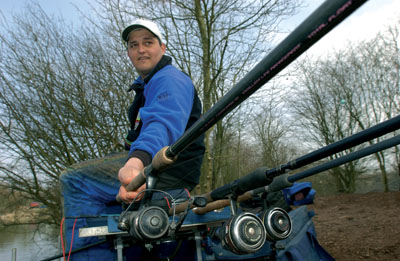 |
| Having rig options helps you keep in touch with the fish. |
One of Ian’s favourite rods for this sort of fishing is the Drennan DRX. Ian says this rod ‘just collapses’ on the strike when the hook sets and that’s what allows him to get away with low-diameter lines.
“That said, in heavily-stocked commercial carp waters, where the roach are not fished for regularly, you can often get away with 0.10mm diameter hooklengths, which is very heavy for roach and gives you an outside chance with a lethargic winter carp.”
Versatility
Ian is fortunate enough to own several rods – enough to set up three different waggler rigs for a day. But don’t worry if you only have one rod – you can still catch well and enjoy versatility by using a quick-change silicone float adaptor, which will allow you to quickly change between a big and small waggler to suit changes in conditions or how far out you need to fish. It will just be a case of adding and taking away a few shot each time so that the float sits right in the water when all the shot have settled, with only the very tip of the float showing above the surface.
When selecting the size of hook, Ian pointed out that he likes to match the hook to the intended hook bait.
“If I was only going to fish with a single maggot there would have been no point in using a size 16 hook, as that would have been too large for the hook bait,” said Ian. “With such a big hook attached a single maggot would not behave naturally in the water and that would lead to fewer bites. For a single-maggot-only app-roach, I’d advise putting on a size 20 hook.
“For double maggot, or even single caster, you can use a size 16 hook because the extra bait will mask more of the hook. However, a size 14 hook is over the top for winter roach fishing on the waggler. I try to get away with the biggest hook that I can, but today I have compromised and settled for a size 17 to give me the opportunity of switching between single and double baits,” he added.
“That said, if I can’t get bites using the single maggot on the 18 then I will have no hesitation dropping to a 20.”
Ian’s Waggler Tips
|
|
||||
|
|
Gently does it
Ian stressed that when you mount bait, great care must be taken not to damage it. Roach are particularly fussy and will avoid bait that looks anything other than natural.
With maggots you have to take care not to ‘burst’ it (so the fluids come out), this is where barbless hooks are a big help.
When hooking a caster, take care not to crush the shell or split it (so the liquid comes out). If you do damage a hook bait, remove it and start again. Get this bit right and you’ll get far more bites.
“Because I am using what I consider to be a biggish hook for single maggot, I have chosen a pattern with a fine-gauge wire,” explained Ian. “It’s the Kamasan B711 pattern, which has a wide gape and nice round bend to it. I like this pattern because it is particularly good for caster hook baits. It also has some ‘guts’ to give you a chance if you do hook something like a tench or carp.”
A pint each of fresh maggots, casters and hemp are all you need for a great day on the roach. Hemp is well documented as a roach attractor and, even in winter, it does seem to draw in and hold a shoal of roach, even if you don’t seem to catch using it as a hook bait.
“Casters have built up a reputation for selecting the better stamp roach,” said Ian. “That said, there are days when a big, fresh, soft bronze or white maggot will tempt the bigger roach. Generally though, maggots are excellent for getting an early response from small roach. Casters take longer to kick in than maggots but, when they do, the average stamp of the roach improves.”
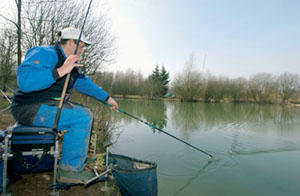 |
| The waggler allows you to fish beyond pole range. Ian has found 18-20 metres to be a good distance to fish at as the fish are not used to being caught here. |
Feeding for roach
Ian says that red, white and bronze maggots are all excellent for taking winter roach, but you must make sure your maggots are fresh, plump and clean.
It’s a good idea to riddle off the old maize flour and sprinkle on some fresh maize to degrease them before setting off on your trip. This helps them sink naturally. Ian likes to fish white or bronze when feeding maggots, but has found red maggots to be an excellent hook bait alternative when feeding casters.
“Roach love to feed on the drop and to encourage them you need to adopt a little-and-often feed-ing principle,” explained Ian, who is in the all-conquering Essex Van den Eynde match fishing team.
“That basically means you should be introducing loose feed into the swim almost all the time, but in modest amounts. For example, 15-20 maggots or casters fed once a minute is a good starting point. That way there will nearly always be a situation where bait is falling through the swim.”
Obviously you need to try and feed the same area each time, so take care if it’s a windy day, as it can affect the distance achieved and the spread of the feed.
“The roach will often feed well off the bottom in winter as they intercept the falling feed, but some days they will prefer to feed in the bottom few inches, even picking bait up off the bottom,” added Ian. You can, to a degree, control the way they feed once they are in the swim. For example, if you want to catch them on the bottom you’ll find that adjusting the feeding so that you feed more maggots or casters, but less frequently, will have the effect of driving the fish down. Feeding less maggots but even more frequently has the effect of bringing fish even higher up in the water. That’s the theory and it usually works, although there are some days when the fish will only feed at the depth they are happy with, however you feed.”
He added that hemp is very good at keeping the fish down on the bottom as it sinks quickly and the fish chase it down.
Ian admitted that he prefers to feed mostly casters and hemp with the occasional pouch of maggots. However he’ll start with double-maggot hook bait before trying casters later in the session.
“If you want to keep the fish down deeper, then alternating casters with hemp is a good feeding strategy,” he said. “It’s a good plan because bites are often much easier to hit when you are fishing deeper.”
Why the waggler?
When deciding how far out to feed and fish, you need to take into account a few factors. In winter the water is clearer in the vast majority of commercial waters, so you need to go a reasonable distance out to avoid spooking the roach and in turn catch for longer. That’s the reason the waggler can very often outfish the pole. However, don’t go out so far that loose feeding and casting the rig accurately become difficult.
“I reckon around 18-20 metres is a good distance and it puts you in the territory just beyond most long poles so that you may have the fish to yourself,” said Ian.
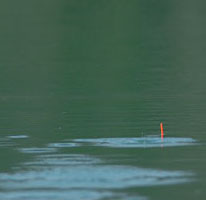 |
| Total-Fishing Top Tip Cast beyond where you are feeding. That way you can draw the float to the far end of the feed as you sink the line and, if you miss a bite, you will still be fishing among the feed after striking, as long as you don’t strike too hard. What’s more the larger fish tend to be at the far edge of the feed. |
“However, my tip is to feed slightly short of where you will be casting. This allows you to cast beyond the feed, sink the line and start fishing with the float and hook bait at the far edge of the loose feed.
A lot of bigger roach tend to hang at the back of the area of feed so it puts you in with a great chance of catching the better stamp of roach.
“It also enables you to have several bites at the cherry if you miss a bite,” he added. “It works like this: the float dips and you strike, but if you miss the bite, as long as you adopt a short-but-sharp striking movement of the rod, the float won’t have travelled too far and will settle again, slightly closer in, but still within the feed area.”
Ian was well into his session by now and was catching a good number of roach. It was great to see a waggler sliding slowly away and the rod tip bucking under protestation from a hooked redfin.
“The theory has been working well because today, even though I have missed bites, the bait has not been marked and the roach are accepting it again closer in. If you miss bites where the bait is damaged then you will have to change the hook bait and I check it between each and every cast,” said Ian, as another plump roach was swung to hand.
On natural venues and hard-fished waters you will find that you have to dot the float right down, fish with the lighter hooklengths and smaller hooks and be very quick on the strike. This is because the roach are much more wary than those in heavily-stocked commercial carp waters where they will often take the bait more readily.
“I would expect to catch fish up to and over 1lb today. They are real quality fish, but there are some monster roach in waters like this that tend to get caught more on bigger baits like bread or scaled-down carp gear like mini-boilie rigs. However, for plenty of bites and bags over 20lb and up to 40lb, you can’t beat this waggler approach,” declared Ian.
Tips for tow
Ian had started the day with a 4AAA straight peacock waggler. He had discovered some tow on the water and, rather than start with the bait just touching bottom, he set the float so there was six inches of line on the bottom instead. Also, he had picked out a straight peacock rather than an insert, because the former would not be dragged under as the bait edged along the bottom.
“Setting up like that enables me to slow the bait down as it travels through the swim – this is more acceptable to the quality roach,” he said.
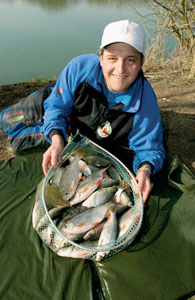 |
| Great angler, great method, great bag of fish. |
“With this rig it does not matter about dotting it down, because there are a lot of roach in this lake and I don’t want to end up striking at false line bites or when the tow drags the float under.”
The reel line on this rod was 3lb breaking strain tied to a 0.109mm Shimano Silkshock hooklength, ending in the size 17 Kamasan B711 barbless hook.
Even with the two however, Ian shotted up with most of the weight locked around the float adaptor. Several No10 shots were then spread along the bottom third to slow the passage of the hook bait.
“If you don’t have enough shot down the line to slow the bait down, you’ll find that the bites tend to be a quick snap rather than a slower suck-in of the bait,” revealed Ian.
On-the-drop set-up
Ian’s second rod was matched with a 3AAA insert waggler with the bulk locking shot either side of the float adaptor, then five No10 shot spread out between float and hook. This allowed a slower drop through the water to full depth and was for capitalising on fish feeding anywhere from the surface to the lake bottom.
The more sensitive, thinner insert helps with shyer bites and he was able to use it because line was not dragging along the bottom.
A shorter, thinner straight 3AAA waggler was also set up, with this one used to fish two feet off bottom when the bait had fully settled, again locked with bulk shot and just four No10 shot down the line. This rig’s purpose was to pick the roach off in the upper-layers of water.
After casting in, Ian sinks the reel line by dipping the rod tip and flicking it back up to whip the line under the surface tension. To connect with fish he advises against a harsh strike.
“Don’t strike like Zorro!” he said. “Just lift upwards to set the hook and then ease the rod to one side, otherwise the fish will come to the surface splashing about on the top and that attracts the attention of pike. If this happens it’s bye-bye quality roach. Roach will also flap around as you go to net them, so slide them smoothly towards the semi-submerged landing net.”
Great session
In front of the cameras, Ian’s session was typical of those he has enjoyed through the winter months, as the roach were quickly on the bait and feeding well.
The ‘dragging rig’ was soon swapped for the full depth on-the-drop rig and he began to catch fish really well in the bottom 12 inches of water.
A quiet spell when the bites slowed up came to an end when he hit a tench, before the roach settled down again. Then another quiet spell was ended with a decent perch, proving the unsettling influence. Some fish fell to the shallow on-the-drop rig, but it was the full-depth insert-waggler rig that was best on this occasion as he ended with a fine bag of big, fat roach that approached a combined weight of 30lb!
“I couldn’t name you any wild venue where I could go and catch 30lb of quality roach like this,” concluded Ian. “Some people are anti commercial fisheries, but I think I have showed they are not all about carp, carp, carp.
“Most of the stocked waters I know of have a very big head of quality roach and, if you are a silver fish man, then you need to get out there and make the most of it.”
How To Plumb The Depth With A Waggler
1 Ian prefers the silicone quick-change float adapters. Most of the float’s capacity is bulked around the base.
2 For the dragging-on rig, No10 shots are placed in the bottom third. For the shallow rig they are spread out equally down the line.
3 For plumbing the depth using a waggler,
Ian simply advises using a heavy plummet with a cork base into which the hook is inserted.
4 Now here’s the really neat bit. He makes a small, loose loop above the float and tightens the loop around the bristle.
5 He then pushes the loop down to the base of the insert. This, although temporary, is enough to hold the float in place top-and-bottom style.
6 You can then swing the float out underarm and, when the plummet hits the bottom, you can easily read the float as it’s just like plumbing with a stick float.
7 Hold the plummet so that you can pull it back to create an arc in the rod tip, with the bail arm open and your finger stopping the line coming off the spool
8 In one movement swing the rig forwards and let the line off the spool. Check the line just as it lands so that the plummet goes in first. Now read the depth.
|
|
Total-Fishing Top Tip
Make sure your casters for feeding are sinkers. To do this place them in a bait box and cover them with water. Any floaters should be removed from the surface of the water but don’t discard them – they make excellent hook baits. A floating caster is much lighter than a sinking one so it counteracts the weight of the hook and the two combined emulate the sinking rate of a caster with no hook attached. Hempseed is also best kept in water to prevent it drying out.


